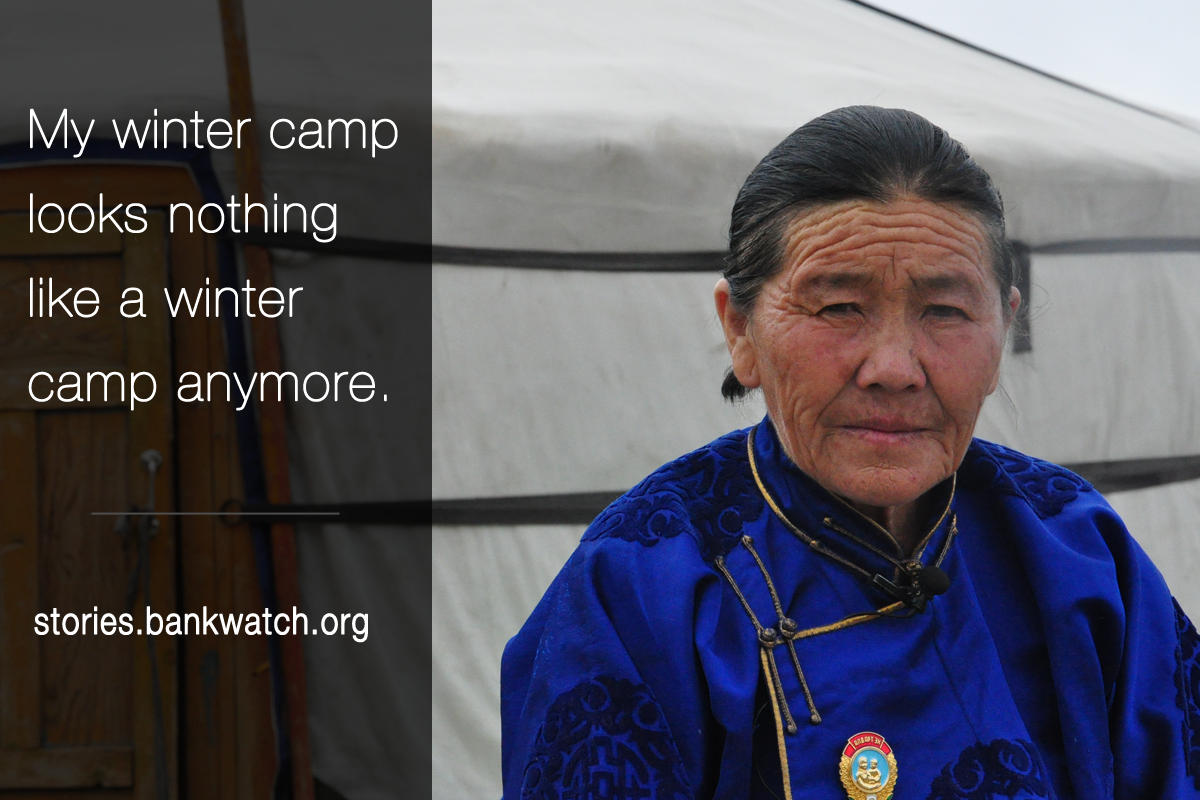ARCHIVED: Mining boom in Mongolia
With huge amounts of unexploited natural resources (gold, copper, coal and more) the Mongolian economy is estimated to grow massively in the years to come. But will it also benefit the people in Mongolia? Our work shows how mining operations lead to pollution and displacement for local herders and exacerbate water scarcity issues.

Father and daughter, resettled by Oyu Tolgoi
Stay informed
We closely follow international public finance and bring critical updates from the ground.
Background
With huge amounts of unexploited natural resources (gold, copper, coal and more) the Mongolian economy is estimated to grow massively in the years to come. But will it also benefit the people in Mongolia? Our work shows how mining operations lead to pollution and displacement for local herders and exacerbate water scarcity issues.
Dust, displacement and intimidation in the Gobi Altai mountains
Nomadic herders in the Gobi Altai mountains are facing pollution and displacement by the Tayan Nuur iron ore mine that receives financing from the European Bank for Reconstruction and Development.
While the mining company Altain Khuder responds to criticism with intimidation, the EBRD is not doing enough to protect herders’ rights.
Read more:
When the dust settles
A multimedia story about herders impacted by the Tayan Nuur mine
Dust, displacement, intimidation – Mongolian herders are under pressure by iron ore mine
Blog post | December 9, 2014
Report: Impacts of the Tayan Nuur iron ore mine on nomadic herders’ lives in Mongolia
Study | December 9, 2014
Case study on the impacts of the global iron ore sector: Altain Khuder in Mongolia
SOMO case study | December 17, 2014
Water scarcity in the South Gobi desert
In the South Gobi desert, the highly intensive mining industry with its immense need for water can pose precarious risks to the livelihoods of herders.
Read more
Spirited away – Mongolia’s mining boom and the people that development left behind (pdf)
Study | January 30, 2012
EBRD financing for mining in Mongolia
By financing several mining projects over the last few years, the EBRD followed other investors’ bias towards the natural resources sector in Mongolia. Instead, it should diversify its portfolio in the country to help Mongolia reduce its dependency on commodity exports.
Read more:
The EBRD in Mongolia: Economic diversity is something else
Blog post | September 18, 2012
Online debate
Following a discussion in the European Parliament on the EBRD’s mining operations, Bankwatch organised a live-streamed google hangout with Mongolian campaigner Sukhgerel Dugersuren.
Latest news
Water disputes persist as Rio Tinto pushes ahead with second Oyu Tolgoi mine
Press release | 11 February, 2016Prague; Khanbogd Soum, Mongolia – A large new copper mine in Mongolia could cause irreversible damage to terrain and deprive water from some of the world’s last remaining nomadic herding groups, finds a new report released today by Oyu Tolgoi Watch, the Bank Information Center, CEE Bankwatch Network and Accountability Counsel.
Read moreInvestigation launched into Mongolian iron ore mine financed by European Bank for Reconstruction and Development for impacts on local communities
Press release | 3 September, 2015Updated September 10, 2015* Amsterdam/Ulaanbaatar/Prague – Last week, the independent accountability mechanism of the EBRD announced it will investigate *the Bank’s compliance with its environmental and social standards at a mine it finances and is operated by Altain Khuder in the Gobi-Altai region of Mongolia. The investigation comes in response to a complaint filed to the EBRD’s Project Complaint Mechanism (PCM) in December 2014 from herders affected by the project.
Read moreEuropean Bank Says Mining Projects Don’t Damage Glaciers
Bankwatch in the media | 8 July, 2015For years, the European Bank for Reconstruction and Development has been involved in the Kumtor mining project, which some experts say is contaminating ground and surface waters. Kyrgyz local communities have been complaining that the gold mine is causing negative environmental and social impacts on the nearby villages. Additionally, international NGOs and Kyrgyz environmentalists believe that the Canadian-operated Centerra Gold mine is triggering rapid glacier melt due to company’s mining practices. The EBRD has denied these claims.
Read moreRelated publications
Joint statement: Urgent call to IFC and EBRD to impose conditionalities on Oyu Tolgoi’s new loan
Joint statement | 20 December, 2024 | Download PDFCivil society organisations from across the globe have signed a joint statement opposing a proposed new loan for the Oyu Tolgoi mine in Mongolia.
The development of Mongolia’s energy sector: Going beyond coal
Briefing | 5 May, 2017 | Download PDFMongolia’s fragile economic situation, with its high deficit and increasing foreign debt, is putting the country on a risk map for foreign investment. Even so, the government and international financial institutions show no sign of adjusting their plan
Asian Development Bank projects in Mongolia
Briefing | 5 May, 2017 | Download PDFWith a dominance of coal in its energy sector, the Mongolian government is planning more than six new coal power plants over the next decade, despite already severe air pollution and public protests against the government’s inaction. The Asian Developm

